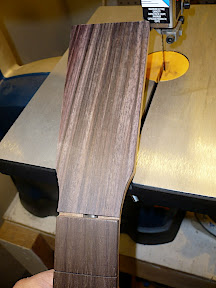No photos tonight. Still building spool clamps. I should complete 7 or so tonight.
So, tonight I started thinking about the specifics of doing the binding. I asked some questions to Steve Summerford @ http://acousticguitarbuild.blogspot.com/ and he had lots of good recommendations.
If I do decide on the hardwood binding I am going to have to come up with a way to bend it. The DIY bending jigs seem like an easy option as I have a few torches around. Steve's blog had recommended soaking the wood in warm water for 30 min. This might be the no additional jig way to go. Heck, I think I am getting tired of making jigs.... nah.
Then I am probably going to attach with CA glue. And heck it will scrape off easily when I am done.
I was recommended to use drafting tape to attach the binding as I go along.
My other option is the black plastic stuff. I don't have to bend that. same attachment methods though.
The wood glue method seems like you can easily go wrong if you get the glue all over the place.
For those of you unfamiliar here is a diagram from Stewmac:

and a good article here on how to:
Here


